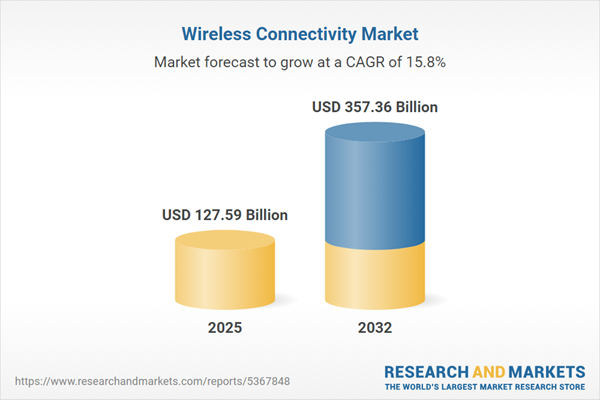Speak directly to the analyst to clarify any post sales queries you may have.
The wireless connectivity market is reshaping enterprise operations, enabling secure, adaptable solutions that drive technology integration and enhance organizational agility. Senior decision-makers find these capabilities essential for efficiency, rapid adaptation, and long-term resilience in digital-first industries.
Market Snapshot: Wireless Connectivity Market Growth & Outlook
The wireless connectivity market is experiencing strong expansion as digital transformation accelerates worldwide. Global revenue is expected to rise from USD 110.26 billion in 2024 to USD 127.59 billion in 2025, and reach USD 357.36 billion by 2032, driven by a compound annual growth rate of 15.83%. Advancements in networking, continuous innovations in business processes, and increased deployment of connected devices are key contributors. Vendors are enhancing their solutions, aligning with shifting regulations, and focusing on robust performance and compliance. Business leaders who adapt to these trends can access significant growth opportunities and ensure sustainable development in a dynamic market.
Scope & Segmentation: Wireless Connectivity Market
Clear market segmentation supports precise investment decisions, targeting the needs of evolving connectivity demands. The wireless connectivity industry is structured around critical segments and drivers:
- Technology Types: Bluetooth offers reliable device connections and seamless integration across systems. 5G and cellular technologies provide the speed and capacity required for enterprise-scale networks. LPWAN supports distributed and energy-efficient applications, while Wi-Fi delivers broad campus connectivity. Zigbee is implemented in automated environments, underpinning advanced smart systems.
- Applications: Connected vehicles enhance transportation efficiency through real-time data. Enterprise wearables promote collaboration and productivity at scale. Healthcare relies on wireless networks for operational efficiency, and automated manufacturing depends on connectivity for streamlined processes. Integrated smart homes use wireless infrastructure for responsive, intelligent controls.
- End Users: Automotive, consumer electronics, energy, healthcare, IT, telecom, manufacturing, retail, and e-commerce industries leverage wireless infrastructure to scale digital transformation strategies, improve productivity, and meet evolving operational needs.
- Components: Advanced antennas, chipsets, RF modules, modular assemblies, and precision sensors collectively ensure signal reliability and enable mission-critical enterprise applications.
- Regions: The Americas, Europe, Middle East, Africa, and Asia-Pacific have unique patterns of investment and adoption, shaped by regional infrastructure maturity, regulatory standards, and varying speeds of digital advancement.
- Key Companies: Qualcomm Incorporated, Broadcom Inc., MediaTek Inc., Intel Corporation, Samsung Electronics Co., Ltd., Texas Instruments Incorporated, NXP Semiconductors N.V., STMicroelectronics N.V., Murata Manufacturing Co., Ltd., and Realtek Semiconductor Corp. play pivotal roles in innovation and industry standard-setting.
Key Takeaways for Strategic Planning
- Enhancing wireless infrastructure strengthens agility and operational continuity while helping organizations meet evolving compliance and technology requirements.
- Deploying hybrid networking solutions supports efficient management of operations and assets spread across multiple locations.
- Assessing readiness and regulatory environments at the regional level enables informed entry strategies and confident expansion planning.
- Collaboration among telecoms, hardware, and software providers accelerates technology rollouts and maximizes returns from connectivity investments.
- Prioritizing network security and advanced analytics increases data reliability and protects vital business operations.
- Implementing low-power wireless solutions in areas like logistics, agriculture, and remote monitoring expands the reach of efficient data transmission.
Tariff Impact: Navigating US Trade Policy Shifts
Forthcoming US tariffs on electronic components in 2025 have prompted wireless connectivity companies to re-evaluate sourcing and supply networks. Strategic moves include increasing domestic manufacturing, developing new supplier relationships, and leveraging predictive analytics to support consistent operations despite shifts in the global trade landscape.
Methodology & Data Sources
This analysis draws from executive interviews, proprietary market intelligence, and technology benchmarking focused on supply chain dynamics. The research process tracks regulatory changes, assesses intellectual property portfolios, and uses scenario-based modeling to underpin actionable recommendations for decision-makers.
Why This Report Matters for Connectivity Industry Leaders
- Comprehensive market segmentation and actionable strategies empower executives to optimize resources and stay aligned with sector demands.
- Continuous monitoring of compliance and industry shifts supports rapid, informed decision-making and organizational influence.
- Detailed analysis of supply chains and market dynamics strengthens business resilience and informs adaptable growth initiatives across regions.
Conclusion
Wireless connectivity supports the advancement of digital transformation and efficient enterprise operations. This report equips leaders with strategic insights to confidently navigate market changes and technology shifts.
Additional Product Information:
- Purchase of this report includes 1 year online access with quarterly updates.
- This report can be updated on request. Please contact our Customer Experience team using the Ask a Question widget on our website.
Table of Contents
3. Executive Summary
4. Market Overview
7. Cumulative Impact of Artificial Intelligence 2025
Companies Mentioned
The companies profiled in this Wireless Connectivity market report include:- Qualcomm Incorporated
- Broadcom Inc.
- MediaTek Inc.
- Intel Corporation
- Samsung Electronics Co., Ltd.
- Texas Instruments Incorporated
- NXP Semiconductors N.V.
- STMicroelectronics N.V.
- Murata Manufacturing Co., Ltd.
- Realtek Semiconductor Corp.
Table Information
| Report Attribute | Details |
|---|---|
| No. of Pages | 187 |
| Published | October 2025 |
| Forecast Period | 2025 - 2032 |
| Estimated Market Value ( USD | $ 127.59 Billion |
| Forecasted Market Value ( USD | $ 357.36 Billion |
| Compound Annual Growth Rate | 15.8% |
| Regions Covered | Global |
| No. of Companies Mentioned | 11 |









